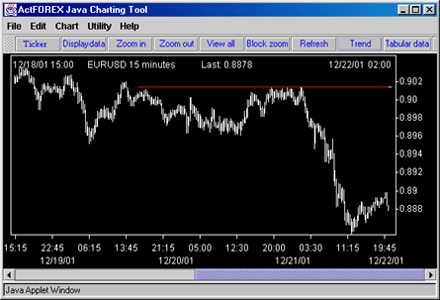|
|
Making trading decisions
and developing a sound and effective trading strategy is an
important foundation of trading.
Sample Strategy 1 - Simple
Moving Average
Successful trading is
often described as optimizing your risk with respect to your reward,
or upside. Any trading strategy should have a disciplined
method of limiting risk while making the most out of favorable
market moves. We will illustrate one decision making
model which uses a Simple Moving Average ("SMA") technical
study, based on a 12-period SMA, where each period is 15 minutes.
This type of study is available in the CFX trading charts. This is
one example of a trading decision making strategy, and we encourage
any trader to research other strategies as thoroughly as possible.
We will use a simple
algorithm: when the price of the currency crosses above the
12-period SMA, it will be taken as a signal to buy at the market.
When the currency price crosses below the 12-period SMA, it will be
a signal to "Stop and Reverse" ("SAR"). In
other words, a long position will be liquidated and a short position
will be established, both with market orders. Thus this system
will keep the traders "always in" the market - he will
always have either a long or short position after the first signal.
In the chart below, the white line represents the price of USDJPY,
the purple line represents the 12-period SMA of USDJPY, and the red
line indicates where USDJPY crosses above the SMA, generating a buy
signal at approximately 129.90:

This is a simple
example of technical analysis applied to trading. Many
strategies used by professional traders make use of moving averages
along with other indicators or "filters". Note that
the moving average method has an element of risk control built in: a
long position will be stopped out fairly quickly in a falling market
because the price will drop below the SMA, generating a
stop-and-reverse signal. The same holds true for a sell signal
in a rising market. Note that the SMA is generated
automatically by CFX's integrated charting application.
Sample Strategy 2 - Support and
Resistance Levels
Another of
technical analysis, apart from technical studies, is in deriving
"support" and "resistance" levels. The
concept here is that the market will tend to trade above its support
levels and trade below its resistance levels. If a support or
resistance level is broken, the market is then expected to follow
through in that direction. These levels are determined by
analyzing the chart and assessing where the market has encountered unbroken
support or resistance in the past.
For example,
in chart below EURUSD has established a resistance level at
approximately .9015. In other words, EURUSD has risen up to
.9015 repeatedly, but has been unable to move beyond that point:

The trading strategy would then be to
sell EURUSD the next time it gets close to .9015, with a stop placed
just above .9015, say at .9025. This would have indeed
been a good trade as EURUSD proceeded to fall sharply, without
breaking the .9015 resistance. Hence a substantial upside can
be achieved while only risking 10 or 15 pips (.0010 or .0015 in
EURUSD).
|
|
|
|
 |
|
| Register Today! |
| Open your account online
and trade globally with the industry's leading in global
trade with no
risk. | |
|
|
|
 |
|
| Now
offering PCB CXC Trading! |
| Trade indices, futures, and
shares online. As always, trading with Charter is
commission free with low margin
requirements. | |
| |
